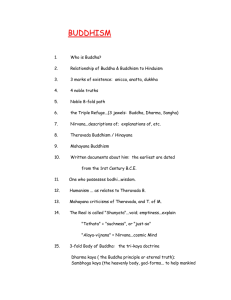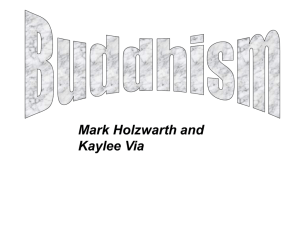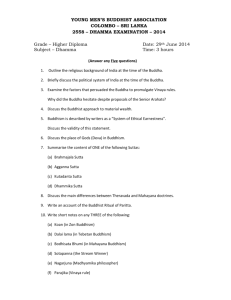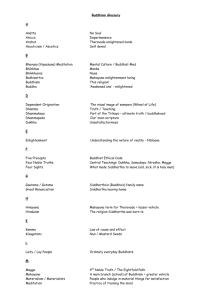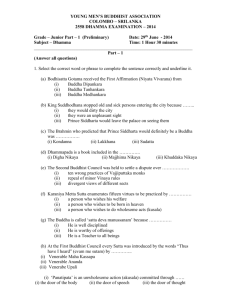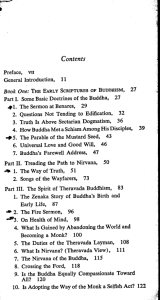Buddhism
advertisement
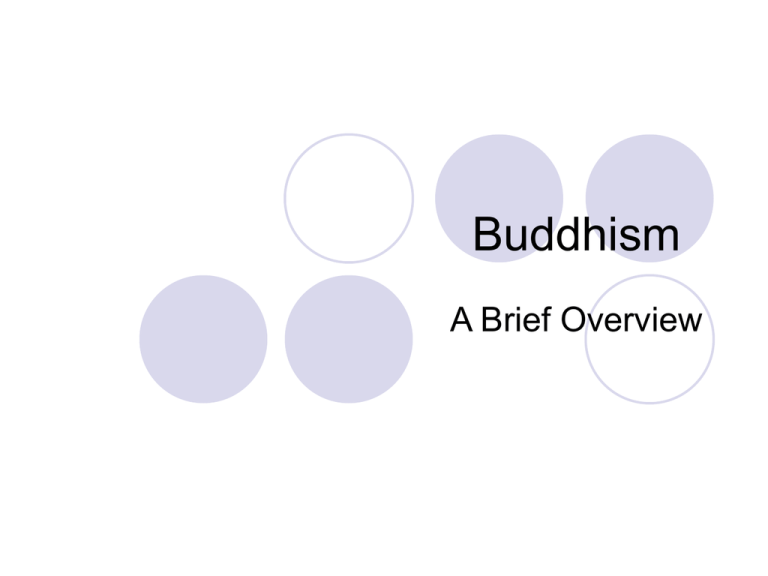
Buddhism A Brief Overview Siddhartha Guatama c. 563-403 BCE Wife was Yasodhara Kshatriya caste Son was Rahula Shakya Tribe NE India (today Nepal) Mother dies shortly after he was born Ruler or sadhu??? Four Sights An Old Person A Corpse A Sick Person A Holy Man Great Going Forth Seeks out teachers Becomes ascetic to the point of death Discovers the Middle Way Finds Enlightment Bodhi or pipal tree Mara tempts him Daughters: desire, pride, greed, ignorance, fear Lord of Death As Himself • Ego • Self-Doubt The Buddha Sanskrit word “to wake up” Awakened One Taught from 35 to his death at 80 Four Noble Truths Dukkha. All life is suffering Anichcha – change or impermanence Anatta – no self, no soul 3 marks Samudaya. Suffering Comes from Desire tanha Nirodha nirvana Eight-fold Path Right Association is foundation Wisdom Elements Right Understanding Right Intention Ethical Conduct Right Speech Right Action Right Livelihood Mental Right Effort Right Mindfulness Right Concentration Panca Sila and Dasa Sila Panca Sila or 5 precepts Abstain from harming living beings – ahimsa Abstain from taking things not freely given Abstain from sexual misconduct Abstain from false speech Abstain from intoxicating drinks and drugs Dasa Sile or 10 Precepts Abstain from taking untimely meals Abstain from dancing, music, singing Abstain from the use of garlands, perfumes, personal adornment Abstain from use of high seats Abstain from accepting silver or gold Teachings Grow 45 yrs work 480 BCE Ragir 380 BCE Vesali Oral Tradition for some four centuries Theravada Buddhism School of the Elders Vada= way Thera = elders Hinayana Yanas = raft Lesser Raft or Vehicle More Common in South (Sri Lanka, Thailand, Cambodia, Laos, Myanmar) Theravada Sri Lanka home base Sangha emphasized Arhat or “worthy” Pali Canon Theravada monks in the 1st century BCE Tipitaka (Ti=three; pitaka=baskets) Three Divisions Sutta Pitaka “Thread” Collections of the Buddha’s sayings in sermons or dialogues Digha Nikaya Majjhima Nikaya Samyutta Nikaya Anguttara Nikaya Khuddaka Nikaya Dhammapada and Jataka Tales Facts and Figures 185 million Mahayana Buddhists (56%) 124 million Theravada Buddhists (38%) 20 million Vajrayana or Tibetan Buddhists (6%) Total of some 329 million; 5.6% of the world’s religious population 98.9% live in Asia Numbers would be greater if there was more freedom of religion in China Two Other Divisions Vinaya Pitaka Book of Discipline for bhikkhus (monks) and bhikkhunis (nuns) Contains 227 rules for how they should live in sangha Also stories of the origins of these rules Abhidhamma Pitaka “the works that go beyond the elementary teachings” More philosophical Mahayana Buddhism Spread NW from India to Nepal, China, Tibet, Japan, Korea, Vietnam, Taiwan Big Raft; accommodates more people, traditions, needs Many schools and Traditions within it Some Common Mahayana Themes Bodhisattva or “Enlightenment Being” Karuna or compassion a goal People strive to achieve enlightenment Heavenly bodhisattvas help Avalokitesvara or Kuanyin popular Three Bodies of Buddha Dharmakaya Law or form body; body of reality Cosmic Buddha nature Universal consciousness that absolute reality Nirmakaya Transformation body Buddha “principle” incarnates Human form of Siddhartha here Sambogakaya Perfect-Bliss Body Buddhas Communicate dharma to Bodhisattvas Shunyata Emptiness or Zero-ness Nagarjuna – 2nd or 3rd century Indian philosopher Samsara, nirvana – all things are empty of inherent existence All teachings of the Buddha are also empty Scripture Tipitaka Vimalakirti Sutra Sanskrit Version Open-Ended and OnGoing Insights. Including: Prajnaparamita Sutra Sutras on the Perfection of Wisdom Saddharma Sutra Lotus Sutra Some Famous Mahayana Schools Zen North China, then Japan Tendai China Pure Land or Jodo Japan Nichiren Japan Zen Ch’an in Chinese from Indian dhyana or meditation Bodhidharma Indian monk to China c. 470 CE Nine years of silent meditation facing a wall More intuitive approach Key Ideas Regular seated meditation or Zazen Kensho or sudden burst of enlightenment Satori or enlightenment is the goal Koans or gong-an (kung-an) Public discussion Riddles or puzzles Sanzen Flag, Wind Two monks were watching a flag flapping in the wind. One said to the other, “the flag is moving.” The other replied, the wind is moving.” Huineng overheard this. He said, “not the flag, not the wind, mind is moving.” Gutei’s Finger Whenever anyone asked him about Zen, the great master Gutei would quietly raise one finger into the air. A boy in the village began to imitate this behavior. Whenever he heard people talking about Gutei's teachings, he would interrupt the discussion and raise his finger. Gutei heard about the boy's mischief. When he saw him in the street, he seized him and cut off his finger. The boy cried and began to run off, but Gutei called out to him. When the boy turned to look, Gutei raised his finger into the air. At that moment the boy became enlightened. Vajrayana Buddhism Diamond Vehicle Branch of Mahayana, but also a kind of “third” vehicle “Hidden” teachings Tibet key. Also Nepal, Bhutan, Mongolia, and other places Mixes Buddhism with “Bon” (pronounce it “pern’) – a native religion A Little History and Teaching 7th century CE Songstan (Song-tsen-gam-po), king of Tibet, sent out learners Buddhism mixed with indigenous religion and tantric practice to form this stream Lamas are revered teachers Thang-kas and mandalas used to assist in focus for meditation Use energy of body to focus the mind Dalai Lama “Ocean of Wisdom” Yeshin Norbu, “WishFulfilling Gem” Kundun, “The Presence” Tenzin Gaytso, 14th Dalai Lama; born 1937 Manifestation of Bodhisattva of Compassion Recognized at age 2 Some Key Details Became leader of Tibet at 16 in 1950 Earned doctorate in Buddhist Studies at 24 Forced into exile by Chinese military occupation in 1959 Won Noble Peace Prize in 1989 "Compassion is what makes our lives meaningful. It is the source of all lasting happiness and joy. And it's the foundation of a good heart, the heart of one who acts out of a desire to help others. Through kindness, through affection, through honesty, through truth and justice toward all others we ensure our own benefit. This is not a matter for complicated theorizing. It is a matter of common sense. There is no denying that consideration of others is worthwhile. There is no denying that if society suffers we ourselves suffer. Nor is there any denying that the more our hearts and minds are afflicted with ill-will, the more miserable we become. Thus we can reject everything else: religion, ideology, all received wisdom. But we cannot escape the necessity of love and compassion." Scripture Kanjur Core From the Tipitaka Tenjur Commentaries Treatises More than 4,000

